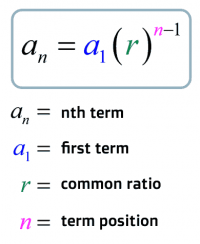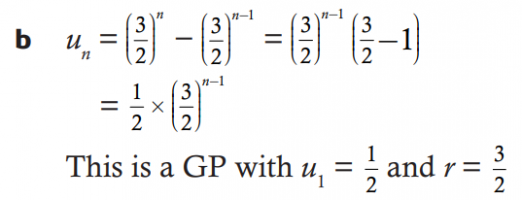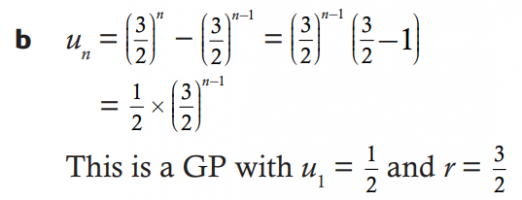alexapprend
New member
- Joined
- Apr 7, 2022
- Messages
- 5
Hello, here is the question from the textbook:
The sum of [math]n[/math] terms of a certain series is given by [imath](\frac{3}{2})^2 -1\\[/imath]
a) find the firt 3 terms in the series (I have done this, but substituting 1, 2, 3 etc and the finding the difference between the sum of 1 and sum of 2)
------[math]\frac{1}{2}, \frac{3}{4}, \frac{9}{8}\\[/math]b) Show that the terms of the series are in geometric progression
My first instinct here is to just find the difference between terms and show that it is consistent (or even just it back in to show that is matches the formula for a geometric progression) but the worked solutions show that it wants you to get it back into the form of a geometric series equation in a different way. Formula we're aiming for:

This is the worked solution:

I can understand the first line shows the same things expanded/factorised but I don't understand where they that line from- it looks like the sum for when n=1 (because then the second term (3/2)^(n-1) would be the power of zero and therefore be 1) but how does that work? You just get to use the sum equation? Is that a known thing that I missed. I also don't understand how the first line can become the second line (I understand taking a half out but I don't understand 3/2 disappearing and 3/2^n-1 staying the same.
Sorry for the dodgy writing of equations, I'm still working out latex. For context: this is IB HL maths- I am self teaching from the textbook. I think this is the correct forum.
The sum of [math]n[/math] terms of a certain series is given by [imath](\frac{3}{2})^2 -1\\[/imath]
a) find the firt 3 terms in the series (I have done this, but substituting 1, 2, 3 etc and the finding the difference between the sum of 1 and sum of 2)
------[math]\frac{1}{2}, \frac{3}{4}, \frac{9}{8}\\[/math]b) Show that the terms of the series are in geometric progression
My first instinct here is to just find the difference between terms and show that it is consistent (or even just it back in to show that is matches the formula for a geometric progression) but the worked solutions show that it wants you to get it back into the form of a geometric series equation in a different way. Formula we're aiming for:

This is the worked solution:

I can understand the first line shows the same things expanded/factorised but I don't understand where they that line from- it looks like the sum for when n=1 (because then the second term (3/2)^(n-1) would be the power of zero and therefore be 1) but how does that work? You just get to use the sum equation? Is that a known thing that I missed. I also don't understand how the first line can become the second line (I understand taking a half out but I don't understand 3/2 disappearing and 3/2^n-1 staying the same.
Sorry for the dodgy writing of equations, I'm still working out latex. For context: this is IB HL maths- I am self teaching from the textbook. I think this is the correct forum.

